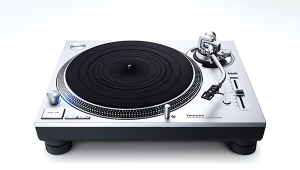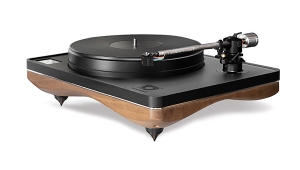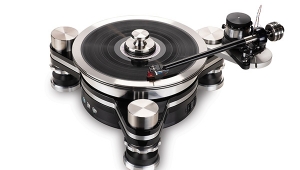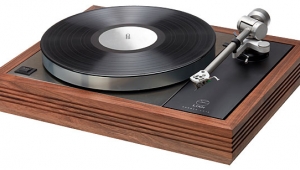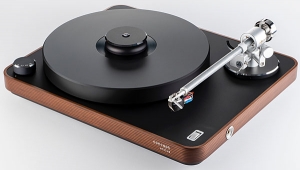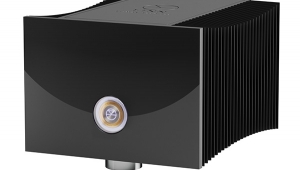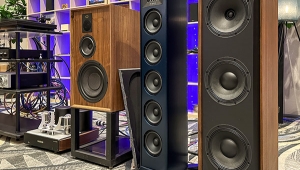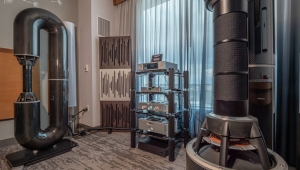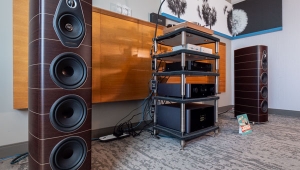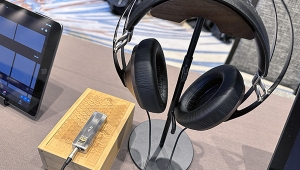| Columns Retired Columns & Blogs |
Oracle Delphi turntable TJN & Delphi Mk.IV part 3
All of the critical auditioning was done using the optional Turbo power supply. According to Oracle, the major difference between this and the standard supply is improved filtering in the more expensive unit to improve isolation from the power line. Toward the end of the evaluation process, I conducted comparisons between the two supplies; they were very close. The differences were definitely not night-and-day, and even with the standard supply I feel that my observations on the Oracle's sound would have been virtually the same. The longer I listened, though, the more I felt that the Turbo supply produced perhaps just a shade more liquid sound, with very subtly cleaner detail. But it was still clear that I was listening to the same turntable when I inserted the basic supply. My advice to potential purchasers is to audition both before deciding to go for the $450-extra Turbo.
Footnote 3: A tiny handful of other manufacturers have attempted the same thing, but none, to my knowledge, so relentlessly over more than ten years.
My auditioning of the Delphi Mk.IV began with the Oracle SME 345 tonearm and the Dynavector XX-1L cartridge. The sound of this combination would not surprise anyone who's read my review of the Dynavector (Vol.14 No.5), though the arm in that case was the SME V. The presentation was tight, focused, open, and detailed, yet without unnatural roughness or brightness. On good recordings, that is. Mike Garson's The Oxnard Sessions, Vol. 1 (Reference Recordings RR-37) definitely tended toward the sparkling and detailed—there was perhaps a very slight degree of warmth, but only enough to keep the presentation from being too analytical. On occasion, I felt that the top end was a bit smeared and perhaps slightly detached from the lower ranges—a dryness crept in which I couldn't totally ignore.
Was it the arm, cartridge, or turntable? The resolution of that would have to come later. But it was not a significant problem on this recording. The overall quality on this and other good recordings continued to impress. Timbres were clear and unmuddled, reproduction of ambience was convincing, the soundstage naturally three-dimensional. The low end, while definitely tending to coolness rather than richness, was deep and tight, the midrange clean and dimensional, and the highs—with the qualification noted above—transparent. Liz Storey's Part of Fortune (RCA 3001-1-N), an unopened LP pressing I found at Recycled Records in Las Vegas during last winter's CES, turned out to be something of a sonic find, despite a horrendous edge warp. The clamping system of the Oracle did not completely eliminate the warp, but the arm and cartridge tracked it without groove jumping. A bit of warp-wow intruded, but otherwise the sound was tightly focused, vibrant, and percussive. The piano was closely miked but not to excess. OK, so this was a digital master. It nevertheless lacked any feeling of digititis, in fact exhibiting a degree of air more common with analog than digital recordings. As with most of the recordings I auditioned, the prevailing impression was of a pristine clarity with no muddle whatsoever.
On less than impeccable recordings, I heard just what you might expect. On James Taylor's Never Die Young (CBS FC 40851), JT's voice had a somewhat rough texture—but not harsh. Imaging remained first-rate. While I wouldn't call this recording's high end zingy or zippy, the balance was very definitely lean and tight. But on Alpha Blondy and the Wailers' Jerusalem (Sterns 1019, available from Linn Selekt Records), the highs were definitely tizzy, spiky, and exaggerated. The vocals were over-reverberant and sibilant. I'm strongly inclined to put a good part of the blame in both of these cases on the program material.
I've referred to my German pressing of Paul Simon's Hearts and Bones (Warner Brothers 92-39421-1) a number of times in previous reviews for good reason—the recording is excellent, and I also happen to like the music. (I don't know if US pressings are as good.) On the Oracle turntable/Oracle arm/Dynavector cartridge setup the voice was wonderfully palpable. The soundstage was precise, there was a convincing feeling of depth, and the spatial placement of the (overdubbed) voices was clearly defined. There was even a respectable, but not overdone, feeling of warmth with this recording. Only a trace of top-end brightness intruded.
Returning to arguably more naturally recorded material, A Feather on the Breath of God (Hyperion A66039, also from Linn Selekt Records) was beautifully focused and balanced. I felt that the sound did perhaps lack a bit of natural warmth, and had just a trace too much sibilance, but otherwise this recording (a digital master, it should be noted) was strikingly well reproduced. Depth, clarity, soundstaging, and inner detail were all first-rate. Nor did I find much to criticize in the direct-to-disc Confederation (Sheffield Lab-9). The presentation, as in most of the recordings noted above and others auditioned as well, was definitely on the light, detailed side rather than sweet or rich, and I did note a trace of dryness and fine grain to the very top end; otherwise, there was little to fault.
Next it was time to swap arms—replacing the Oracle/SME 345 with the SME V. This was actually after several months of listening to the Oracle arm—which should indicate that I certainly found the Delphi Mk.IV with the Oracle arm to be a very satisfying combination. With the SME V, the overall presentation was, however, definitely upgraded by more than a step—not a dramatic improvement, but a more relaxed, natural presentation. The sound had a bit more warmth, and the top end was no less detailed, though better integrated with the whole. Less obvious, but no less welcome, were small improvements in depth and overall high-frequency balance. This improved even some marginal recordings; Jerusalem had a stronger, tighter bass, its high end was less relentless, and I noted an improved differentiation of inner instrumental voices. The change was not pronounced enough to make me like the recording, but it was a noticeable improvement.
On L'art de La Flute de Pan (Arion ARN 36779), the highs, which with the Oracle arm had seemed to be somewhat off by themselves, were now somehow more believable—the breath sounds from the pipes now merely added natural character to the presentation. Overall, the SME V removed a trace of sharpness from the sound without in any way dulling it or reducing detail, while at the same time adding a welcome degree of warmth.
Replacing the Dynavector cartridge with the Benz-Micro MC-3 produced the same results I reported on in my review of the Dynavector (Vol.14 No.5). The Benz has a richer, fuller, more "tubey" sound than the Dynavector. This is both a plus and a minus. The MC-3's more relaxed, less tightly wound presentation was relaxing and easy to listen to, yet it certainly did not lack detail. Its slight softening flattered some recordings, but its subtle way of making the most of what was in the grooves without calling attention to itself continued to be appealing. Yet there were times when I definitely missed the Dynavector's attack, clarity, and, well, snap (to use an old JGH term which remains descriptive). Listening to both of these cartridges makes it clear why there are audiophiles with more than one cartridge—though I suspect fewer today than in the past. As I stated in my Dynavector review, that which works best for you will depend very much on the rest of your system.
But this is not, of course, a cartridge review. Still, I was beginning to home in on what appeared to be the sound of the Oracle, or more precisely, its relative lack of a "sound." It seems to avoid any trace of excess warmth and fullness, generally coming across as quick, tight, and clean. But it does not lack for warmth when partnered with a cartridge/tonearm combination which tends in that direction; ie, the SME V with the MC-3. It was dead silent, and except for the episode with the belt, was totally reliable in use.
But determining the true sound character of a turntable can be an elusive search. It's simply not possible to audition any turntable with an unlimited variety of arms and cartridges to establish a definite trend, and a turntable should, ideally, be considered as a system—with tonearm, arm, and cartridge perfectly matched and synergistic. At least that's what JA keeps saying as he goes home each night to his Linn/Lingo, Ekos, and Troika. Linnies have it easy—the maker of their system has been refining the sound of the combination for years. That does not mean that it is necessarily the best there is, but it does mean that when you acquire such a system you will hear the turntable more or less as the manufacturer intends that you should—given decent setup (footnote 3).
Footnote 3: A tiny handful of other manufacturers have attempted the same thing, but none, to my knowledge, so relentlessly over more than ten years.
- Log in or register to post comments
